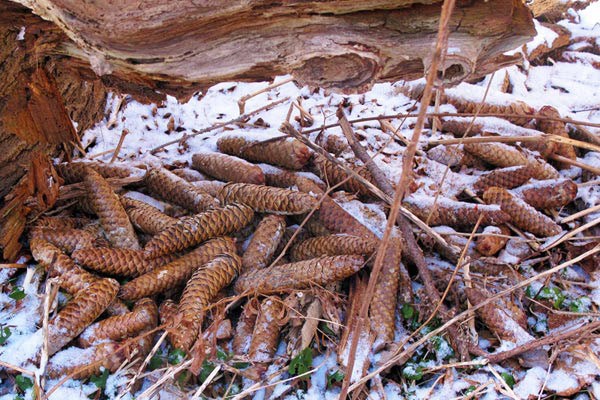The Latin name for the red squirrel, Tamiasciurus hudsonicus, gives us more than a hint about the summer and fall foraging behaviors of this bold and busy creature. Tamias apparently has a variety of meanings in Greek, including distributor, storer, and steward. Every outdoor enthusiast has seen what goes on out there: once cones are mature, red squirrels clip them from the trees and carry them to caches throughout the forest. Small cone-bearing nip twigs can be found on the ground, and a hand lens will often reveal the tiny grooves caused by squirrel incisors, as well as the angled cuts indicative of how these small rodents remove the twigs from the tree.
Unlike the scatter hoarding behaviors of the gray squirrel, where individual nuts and other foods are cached in numerous shallow burials, the red squirrel is a larder hoarder. Conifer seeds are its chief winter food, so hundreds of cones may be clipped from the trees and cached in central locations. The most conspicuous sign is of a midden – a large accumulation of cone seeds, scales, and stripped cone cores, as well as some stored cones whose seeds have yet to be extracted and eaten. The cones of some conifer species, such as red pine, have scales that must be cut off in order to access the seeds. By contrast, hemlock, spruce, and fir have thinner scales that can be stripped off the cone axis. Heirloom middens may be several feet in diameter, and more than a few feet thick. Midden sites are often deliberately established beside streams or seepage areas, or under moist logs, large leaning stumps, or root wads. The accumulated midden refuse, coupled with the site’s moist environment, helps keep the cones closed and preserves the seeds longer.
Everyone is familiar with the red squirrel’s “squirrely” behavior – the nervous running about, the scolding, and the fierce defense of its territory. There’s good reason for this. Squirrel researcher Fritz Gerhardt discovered that the feisty squirrels constantly stole cones from each other’s caches. Gerhardt color-marked each individual cache’s cones and found that 25 percent of them changed ownership, and nearly 100 percent of the squirrels in his study participated in pilfering.
Last year was a cone mast bust. The many squirrels living around my cabin really struggled to find enough to eat and store for the winter. For the first time in nearly 40 years, some squirrels insisted on moving into my place. They terrorized my house cats. One squirrel perched on my cook stove, eating from a box of Triscuits. It scolded me when I drew near and told me in vociferous squirrel language to “get the #$!& out of my kitchen!” Squatters’ rights indeed! They even clipped and cached the red, cone-shaped LED Christmas lights that surrounded the frame of my front door – 42 in all.
As a wildlife photographer, I have succeeded in getting grand pictures of grizzlies, wolves, lynxes, and bobcats. What I dream about, though, is the opportunity to capture a clear image of what I have seen so many times. Picture a red squirrel descending a white spruce trunk. With sap-stained lips, the squirrel is carrying the long cone on end in its mouth which looks for all the world like a fine Havana cigar.



Discussion *